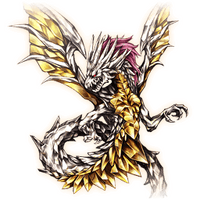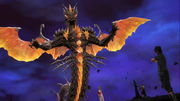
Shinryu in Dissidia NT Final Fantasy
An ancient dragon dwelling in the Dimensional Rift. A massively strong will once consigned it to a certain task, but all details are unknown. It often rains devastation on those who would destroy it, causing even gods to fear its strength.
Dissidia description.
Shinryu (神竜, Shinryū?) is a major antagonist in the Dissidia Final Fantasy series. A powerful divine dragon that wanders between dimensions, it is one of the major instigators of the cycles of war in World B, seeking to exploit the conflict to empower itself.
History[]
Shinryu visited World B as a whim to rest there during its travels across the rift. Some time later Cid of the Lufaine, Cosmos and Chaos arrived in the world and began to battle, catching Shinryu's notice. He met with them and formed a pact with Cid - Cosmos and Chaos would war with each other while Cid gave up his physical body to become an immortal soul. Shinryu's role in the cycles was to revive the warriors the two gods summoned if they should fall in battle, a process that came to be referred to as purification, and in exchange Shinryu would absorb the memories and expended strength of the fallen warriors to grow stronger. With this agreement the cycles of war began, and each cycle's end was marked by Shinryu's descent into World B to restore the fallen warriors and take its bounty from them.[1] Cid thought this power was the power to revive the dead, but in reality Shinryu was absorbing their power as they lay on the cusp of death, and then returned them to the world. When a warrior had no more power left to give Shinryu, it allowed them to perish.[2]
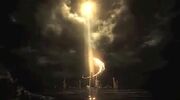
Shinryu restarts the cycle.
During the twelfth cycle, Exdeath found a portal into the rift in World B and discovered the manikins, remnants of Cid's experiments with artificial crystal found in World B. Exdeath released the manikins into World B for the champions of Chaos to use as warriors to fight the warriors of Cosmos.[3] Several of Cosmos' warriors went to the door to the rift to close it and stop the tide of manikins, while the Warrior of Light remained behind to defend Cosmos against an immeasurable swarm of the entities. Cosmos expended her strength to defend him, and the cycles were brought to a close soon after. Shinryu descended and resurrected the fallen warriors, and the Warrior of Light witnessed the process before his strength faded and he collapsed.[4]
As the thirteen cycle began, Cid was moved by Cosmos' decision to use her power to protect the Warrior. He realized he had become no different from the military nation that had cost him everything, and wished for an end to the cycles with Chaos' destruction. To aid them, Cid created two teleport stones to save the warriors near the end of the thirteenth cycle. However, this was a violation of the pact with Shinryu; Cid was to remain a neutral observer in the cycles.[5] Shinryu approached Chaos and informed him of Cid's betrayal, and lent him his strength for the final battle against Cosmos' warriors that were approaching his domain.[6] When Chaos was defeated, Shinryu offered him the chance to take revenge on Cid. Chaos accepted and Shinryu sealed Cid's soul away, then absorbed Chaos' remaining strength and departed to the rift.[1]
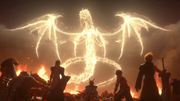
Shinryu descending to battle the summoned warriors in Dissidia Final Fantasy NT.
At some point the wills of Cosmos and Chaos were reincarnated as Materia and Spiritus.[7] World B was sliding into ruin, and the two summoned warriors from other worlds to fight and generate energy to sustain the world.[8] Shinryu again attempts to absorb the strength released by the conflict, this time by sending harbingers called planesgorgers into the world, which are drawn to battles between the summoned warriors. In doing so, it absorbed the energy that Materia and Spiritus intended to use to stabilize World B, and the world slid closer to ruin.[9] Having learned that Materia and Spiritus shared the desire to protect World B, the summoned warriors of both gods convinced them that Shinryu was a mutual enemy and the true threat to them all, and the two sides agreed to work together to defeat Shinryu.[10] The two forces clashed in a great battle that drew Shinryu itself to the battlefield, and they then turned their attention to it and attacked. Shinryu was destroyed and the summoned warriors returned to their respective worlds.[11]
Other continuities[]
In the original Dissidia's bonus storyline Inward Chaos, Shinryu speaks to the player's character as they fight through their opponents. Inward Chaos takes place in a realm where Chaos was never defeated and the cycles continued, and he wallows in despair at the end of the world. Shinryu believes this realm should not exist and tells the player's character how the realm came into existence and what happened here. When Chaos is defeated the realm fades from existence, and Shinryu is grateful for its duty to be ended. It expresses hope that if it meets the player's character again, it will be able to view the world as they do, rather than from above as a divine observer.[12]
In Dissidia 012's storyline Confessions of the Creator, Shinryu imprisons Cid in a nightmare realm where Chaos was not defeated in the thirteenth cycle, and the cycles continued. After the 18th purification, Chaos had grown so powerful that his power corroded his mind, and in the 19th cycle he went berserk and transformed into Feral Chaos. Chaos destroyed all of the summoned warriors, even his own, and rampaged until Cosmos had no strength to summon more. Meanwhile, Shinryu continued to absorb power from the cycles and transformed into Shinryu Verus. When the 20th purification ended and Cosmos near-death, all of the summoned were defeated and Cid sealed Cosmos in the Chasm in the Rotting Land to protect her from Chaos. Chaos instead turned on Shinryu and the two fought with enough force that it threatened to destroy the world, but their strength was equal and neither could destroy the other. Cid cut off the northern areas where they dwelled for Cosmos' safety, giving up his powers to do so. At the end of the storyline, Chaos and Shinryu are defeated and Cid's soul is freed from the nightmare.[2]
Dissidia Final Fantasy Opera Omnia is based on the premise of Dissidia NT. Shinryu acts as the main antagonist of the first two acts of the game. At the end of act one, one of its planesgorgers devours the crystal core that stabilizes the world's existence, but Materia reveals it was merely a crystal core of light, there is also a crystal core of darkness, and it now sustains the world alone. Act two sees the summoned warriors confront more planesgorgers, and over time the strain of maintaining the world's existence without its counterpart causes the crystal core of darkness to lose it power. The world begins to crumble and Shinryu devours the crystal core. The summoned warriors pursue it to stop the world's demise, while others defend Shinryu intending to take its power for themselves. Eventually Shinryu is defeated and the crystal core of darkness shines with a new light, causing the world to be reborn.
Characteristics[]
Appearance[]
Shinryu's appearance is based on its original appearance in Final Fantasy V. It is a large silver dragon seemingly made of living crystal that juts out of its body, particularly on its stomach. Its underside and the lining of its wings are gold, and it has red hair, two claws, and a long tail. It often appears as a glowing, incorporeal form as a golden dragon that is much larger than Shinryu itself and has a much longer tail, and leaves streaks of light in its wake. As Shinryu Verus, Shinryu is a palette swap of its original form that is primarily gold with red stomach and wings and black hair.
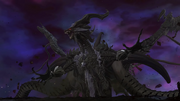
Shinryu's transformed state in Dissidia NT.
In Dissidia NT, Shinryu is pale gray and glows white when attacking, and its hair is a dark purple. It is more clearly a biological being instead of a crystal entity, and its stomach is the same color as the rest of its body with gold crystals jutting out in various places. In its second phase it turns dark gray and black, and the gold parts turn light gray. It is larger and grows two additional tails extending from the base of its wings, and multiple tentacles emerge from its back.
Personality[]
Shinryu has minimal dialogue in the Dissidia games, but it demonstrates contempt for humanity as weak, fragile mortals, and values power above all else. In the Reports of Dissidia 012 which contain a fragment of Shinryu's words to Cid, it has an archaic speech pattern that it does not demonstrate when it speaks to Chaos at the end of the thirteenth cycle. Shinryu desires power and makes the pact to begin the cycles of war to gain power through the battles of the summoned warriors, and it is dubious of Cid's desire to return home but allows him to choose to hold onto that hope if he wishes.[13] Shinryu can be manipulative; it is said to have "seduced" Chaos to allow it to absorb his remaining strength when he perished, and it convinced Chaos to take revenge on Cid for violating his neutrality.[1] It told Cid it would "ready a purified vessel" if the corpse of a fallen warrior was offered to it.[13] Cid took this to mean Shinryu was resurrecting the dead, but all it was doing was absorbing their memories and returning them to the cycle. When Cid realized this truth, he felt he had been tricked, since Chaos' warriors would keep growing stronger as they continued to win while Cosmos' warriors would stagnate without the experiences of their past battles.[2]
It is ambiguous if Shinryu in Dissidia NT is actively malicious or not. It continues absorbing the power expended by the summoned warriors in their battles as it did in the previous cycles, but it is not made clear if Shinryu is unaware that doing so will indirectly cause World B to be destroyed, or if it is aware and does not care. Regardless, its actions make it the true enemy to the world and those within it. When attacked it grows angry and violently retaliates against the summoned warriors, attempting to destroy them.
Abilities[]
Shinryu is terrifically powerful, able to imbue Cosmos and Chaos with power to be as gods and granting Cid immortality to exist without a physical form. It can absorb the memories of mortals to grow stronger, and also absorb the energy expended when they do battle. Shinryu is able to copy the effects of summoned monsters, attacks with blasts of elemental energy, summon cyclones around the arena, and can fire myriad beams of light to bombard opponents. In its second form in Dissidia NT, Shinryu attacks with dark energy in the form of various beams, blasts, and geysers from the ground, it can blast opponents across the arena with a roar, and uses its additional two tails to slam the ground creating explosions of darkness. Defeating Shinryu requires the combined efforts of all the warriors Materia and Spiritus have summoned, who each themselves are strong champions and in some cases are also god-like beings in their own right. Materia and Spiritus bind Shinryu with magic seals as the summoned warriors concentrate their power into one attack from the Warrior of Light, and Shinryu emerges unscathed. In Dissidia 012, Shinryu Verus is stated to be Shinryu's final form once it has imbued itself with enough strength, and the full extent of its power is beyond human comprehension.[14]
These feats posit Shinryu as potentially one of the most powerful beings in the Final Fantasy multiverse, a god beyond gods.
Gameplay[]
Dissidia Final Fantasy (2008) / Dissidia 012[]
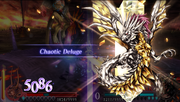
Shinryu being summoned.
Shinryu acts as Chaos' unique summonstone. Unlike normal summonstones, Shinryu can be summoned as often as Chaos wishes and whenever it wishes, though there is a cooldown after each use, shown by Shinryu's summonstone reappearing above Chaos' HP bar. Shinryu's summon attack is Chaotic Deluge, and it copies the effects of other summonstones depending on the current round of the fight and the status of Chaos and his opponent. Shinryu's activation can be sealed by Ramuh and Asura, and its activation can be forced by Asura, in which case Shinryu's effect will be random among the effects it could activate in the current round. However, Asura cannot break Shinryu's summonstone. Chaos will not summon Shinryu during the first round of the battle; if the player uses Asura to forcefully activate it in Round 1, Shinryu may use any of its effects.
The effects Shinryu can activate are:
- PuPu: used if Chaos is afflicted with Break in Round 2, halves his Bravery and then repeatedly increases it over a period of time.
- Omega: used if neither fighter is afflicted with Break in Round 2, repeatedly halves the player's Bravery over a period of time.
- Ifrit: used if the player is afflicted with Break in Round 2, multiply's Chaos' Bravery by 150%.
- Lich: used if the player's Bravery is higher than Chaos' HP in Round 2, summons a timer that depletes the player's Bravery when it ends.
- Alexander: used if Chaos' Bravery is close to or higher than the player's HP in Round 2, freezes Chaos' bravery for a period of time.
- Behemoth: used if Chaos' Bravery is close to or higher than the player's HP in Round 2, doubles his Bravery and then repeatedly lowers it over a period of time.
- Iron Giant: used if neither fighter is afflicted with Break in Round 2, causes Chaos' HP attacks to halve the player's Bravery.
- Ultima Weapon: used if either fighter is afflicted with Break in Round 2, builds power and eventually inflicts Break on the player.
- Tiamat: used if neither fighter is afflicted with Break in Round 2, summons a timer that triples Chaos' Bravery when it ends.

Shinryu Verus summoned
In Dissidia 012, Feral Chaos has access to a variant of Shinryu called Shinryu Verus when fought at the end of Confessions of the Creator. Shinryu Verus' summon attack is Savage Roar, and its effect is entirely random and copies one of the effects of the Four Fiends, but with timers each of only 20 seconds instead of the original's. These effects are:
- Tiamat: triples the summoner's Bravery once the timer reaches 0.
- Kraken: swaps both players Bravery once the timer reaches 0.
- Marilith: freezes the opponent's Bravery once the timer reaches.
- Lich: depletes the opponent's Bravery to 0 when the timer reaches 0.
Dissidia Final Fantasy NT[]
Shinryu is the final boss of the game's story mode, and may also be fought as a bonus battle at the end of the summon trial mode. The player must defeat Shinryu in both forms to win the battle entirely. Their KOs stocks are refreshed between the battle, but they cannot change their party or their abilities. Shinryu immediately opens the battle with Tidus Wave, so the player must dash to the side instantly to avoid taking HP damage. Shinryu's other HP attack in this phase is Levinbolt, a pinpoint attack that can be avoided by dodging away from the area of impact quickly. Its Bravery attacks are to summon cyclones around the arena that persist for a long time, firing three orbs of dark energy that track their target and inflict Poison on hit, firing a blast of ice horizontally in front of it, and firing a large beam of fire across the arena from its mouth. After falling to half HP, Shinryu will gain the buffing move Chaotic Deluge, which will randomly double its Bravery, freeze its Bravery, or inflict Doom on the party that cannot be dispelled. It gains a new Bravery attack where it flies forward strafing the ground with its breath, and its ultimate attack Fulgent Rain. This attack has Shinryu fly beyond the boundaries of the arena and summon numerous portals that bombard the arena with light projectiles that deal HP damage. The best way to avoid this is to wait until the projectiles begin to fire, then dash towards Shinryu and the attack will strike behind the player. Shinryu has 30,000 HP.
In his second form, Shinryu remains stationary on the edge of the arena. It will attack with a blast of darkness from its mouth straight forward, slamming the ground beside its head with its tails to create explosions of darkness, swiping its claw in a large area in front of it, firing a large orb of darkness that tracks the target and eventually explodes, and summoning geysers of darkness from the ground that leave pools of darkness in their wake. It can use Screech of Oblivion to blast all characters to the opposite side of the stage, and may follow this up with Intimidation, inflicting a debuff that depletes their dash gauge. The orb of darkness can also inflict Intimidation, and the pools of darkness it creates can inflict Stop. It can also buff its defenses with Aegis. Its HP attacks are Trinity, which casts Judgment Bolt, Diamond Dust, and Hellfire in succession; and Cimmerean Rain, which is similar to Fulgent Rain but the orbs strike over a larger area and into the air. Its ultimate attack is Arrant Calamity, where Shinryu covers most of the arena in an aura of darkness and charges energy before creating an explosion in the effected area - only the very far edge of the arena opposite Shinryu is safe. Shinryu has 40,000 HP, and unlike other bosses does not become immune to HP damage at half health.
Behind the scenes[]
Allusions[]
- Though not all of them are named as such, Shinryu's attacks as a boss in Dissidia NT mirror its recurring attacks when fought as a boss in other Final Fantasy games: it has its signature Tidal Wave, Levinbolt in place of Lightning, its cyclone attack is based on Maelstrom, its fire blast attack is based on Atomic Ray, its freezing breath attack is based on Icestorm, and its dark orbs that inflict poison are based on Poison Breath. Finally, its strafing breath weapon is based on Earth Breath, an attack it possesses in Final Fantasy XIV. The effects of Chaotic Deluge are based on the effects of Shinryu Verus in Dissidia 012, though they are not entirely the same: freezing Shinryu's Bravery, doubling it, and inflicting Doom on the opponent.
Etymology[]
Shinryu is the Japanese on'yomi name for Shénlóng, literally "god/divine dragon", an important ancient dragon in Chinese mythology. It is said to preside over storms and rain, and can bring disastrous drought, thunderstorms and general bad weather if it feels neglected and/or angered.
Though Shinryu's name is taken from the East Asian dragon which normally is depicted with four claws and no wings, it does not greatly resemble the mythological Shénlóng, as it originally had five claws on each hand as opposed to four as a way to show higher-rank (as well as sharing the same azure color as another mythological dragon, the Qīnglóng/Seiryu).
The Final Fantasy depiction of Shinryu's most iconic recurring design more closely resembles the European wyvern, a dragon-like serpent with two claws and two wings.
Verus is Latin for "True".
References[]
- ↑ 1.0 1.1 1.2 Dissidia 012 Final Fantasy, Character Files: Shinryu
- ↑ 2.0 2.1 2.2 Dissidia 012 Final Fantasy, Confessions of the Creator
- ↑ Dissidia 012 Final Fantasy, Character Files: Exdeath
- ↑ Dissidia 012 Final Fantasy, Cutscene: The Twelfth Purification
- ↑ Dissidia 012 Final Fantasy, Character Files: The Great Will
- ↑ Dissidia 012 Final Fantasy, Cutscene: The Dragon of Ruin
- ↑ Dissidia Final Fantasy NT, Cutscene: Nature of the Enemy
- ↑ Dissidia Final Fantasy NT, Cutscene: Divine Schism
- ↑ Dissidia Final Fantasy NT, Cutscene: World in the Balance
- ↑ Dissidia Final Fantasy NT, Cutscene: Fighting Chance
- ↑ Dissidia Final Fantasy NT, Cutscene: Shinryu, the Planesgorger
- ↑ Dissidia Final Fantasy, Storyline: Inward Chaos
- ↑ 13.0 13.1 Dissidia 012 Final Fantasy, Report 13
- ↑ Dissidia 012 Final Fantasy, Summon Compendium: Shinryu Verus


